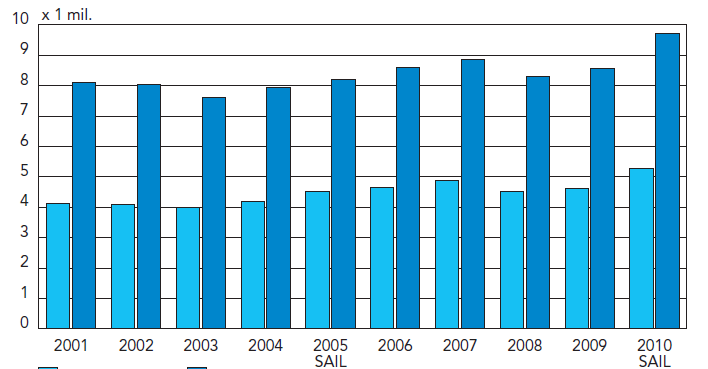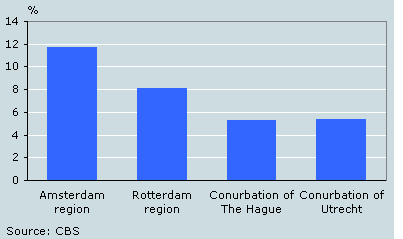Executive Summary
The tourism industry in Amsterdam has become important for the economic development of the city. It attracts millions of people who may have different lifestyles, interests, and values. It is characterized by extreme competitiveness among businesses. The growth of this economic sector can be attributed to the cultural heritage of Amsterdam and entertainment opportunities that it can offer. This area of economy is still open to new entrants.
Introduction
This report is aimed at examining the peculiarities of tourism industry in Amsterdam. In particular, it is necessary to focus on the way in which various external and internal factors can shape it. Much attention should be paid to political, social, economic, technological, and other forces. Moreover, one should concentrate on the competitive environment of this industry.
In this context, the term tourism industry can include various organizations such as hotels, restaurants, travel agencies, and other businesses. Contemporary Amsterdam attracts people who have different values, priorities, or interests (Dunford 2003, p. 53). This popularity of this city gives rise to the development of a very competitive tourist industry (Statistics Netherlands 2012). These are the main issues that should be examined.
Industry Analysis
Industry overview and major trends
This paper will be focused on hospitality institutions that operate in Amsterdam. Among them, one can distinguish hotels, restaurants, cafes, resorts, and other organizations that provide services to travelers. In the global context, its role is not very important since it constitutes only a small fraction of the national economy. Nevertheless, it does contribute to the development of global economy.
For instance, in 2010, the city was visited by 5.3 million tourists (Research and Statistics Economic Development Department, 2011, p. 1). They brought extra revenues to airlines, and travel agencies that could be located in various countries. Overall, researchers believe that there are positive trends in the development of the Amsterdam tourism industry.
In particular, they look at such indicators as the number of tourist arrivals or bed nights (see Appendices, Picture 1) (Research and Statistics Economic Development Department, 2011, p. 1). Even during the economic recession, these indicators were growing. For example, the number of tourist arrivals grew by more re 10 percent during the period between 2007 and 2009 (Research and Statistics Economic Development Department, 2011, p. 1).
Therefore, tourism industry in this city is resistant to the effects of global recession. This is one of the main aspects that should be taken into account.
The city of Amsterdam and tourism
Amsterdam can be viewed as the commercial and technological centers of the Netherlands. According to various rating agencies, this city is one of the most comfortable ones (Hobbes 2009, p. 115). This means that it has necessary infrastructure, educational organizations, recreational facilities that are important for the wellbeing of an individual. Furthermore, the city hosts numerous attractions such as Van Gogh Museum, canals, Hermitage Amsterdam, cannabis coffee shops, and so forth. Therefore, this city can appeal to tourists with different values and attitudes.
There are two important effects of globalization on this city. In particular, one can speak about the growing number of in-coming travelers and intensification of trade. Currently, the population of Amsterdam is 802,938 people. In turn, the Amsterdam Area has 11 percent of the national GDP (see Appendices, Picture 2) (Statistics Netherlands 2012). The economy of Amsterdam as well as the Netherlands is formal. This means that businesses are monitored and regulated. The main consequence of this regulation is that the rights of clients are better protected. These are the main aspects that can be singled out.
PESTL Model
The external environment of the industry can be examined with the help of PESTL model that can throw light on political, legal, economic, technological and ecological forces.
Political and legal environment
The government of the Netherlands can be described as a parliamentary democracy and constitutional monarchy. This country does not face any risk of civil conflict or political instability. The strong protection of property and civic rights is the main political and legal factor that will contributes to the growth of hospitality industry (Musterd 2003, p. 88). For instance, it can lead to the increased flow of direct investment into various hotels, restaurants or other hospitality institutions. There are other forces that strengthen the confidence of investors and customers.
Among them, one can single out transparency of the legal system and extremely low levels of corruption (Taekema 2011, p. 7). Moreover, economists focus on such an indicator as ease of doing business. Amsterdam is ranked 26th in this rankings (Amen 2013, p. 186). Therefore, the representative of the tourism. Industry can find this legal and political environment very attractive.
Economic forces influencing the tourist industry in Amsterdam
The growth in this industry is determined by the increasing globalization and the growing number of travelers. Hospitality institutions can be affected by various economic factors. Much attention should be paid to the purchasing power of clients who come from other European countries and the United States. Therefore, the tourism industry in Amsterdam can be influenced by many other industries.
The Netherlands is regarded as a country where entrepreneurs can easily find credit for their businesses. Moreover, the country is an advanced economy with very low inflation rates (Banach 2008, p. 58). One can say that the tourism industry in Amsterdam is very competitive. This is why it is difficult for a single company to gain leadership. They have to provide services with the best ratio of price and quality.
Socio-cultural environment and tourism industry in Amsterdam
There are several social and cultural forces that can be important for the development of tourism in Amsterdam. Although, Dutch is the only official language, local people can also speak German, English, and French. Therefore, tourists do not find it difficult to communicate with local people. It should be noted that religion does not play a strong role in the social or cultural life of the country.
Moreover, the cultural norms adopted in the Netherlands as well as Amsterdam tolerate different forms of religious worship. This issue is also of great importance to leisure travelers. Finally, one should remember that the country has legitimized the use of cannabis, and this policy led to the growth of drug tourism in Amsterdam (Dunford 2003, p. 53).
Technology and the tourism industry
Technology has been critical for the hospitality institutions in Amsterdam because with its help they can better attract clients. For instance, many hotels and restaurants develop their own websites in effort to attract clients from various countries. Amsterdam can also be viewed as a place where technological innovation is encouraged.
As a rule, the emphasis is placed on the adoption of technologies which can reduce the pollution of water, air, or soil (McDonald 2011). This issue is particularly relevant if one speaks about transportation. This policy makes the city more appealing to tourists. Overall, Amsterdam has a well-developed infrastructure which includes information technologies, sea transportation, and advanced medical care.
Ecological and environmental challenges
The main environmental challenge is the increased risk of floods. It affects various types of businesses including hospitality organizations. They have to spend extra costs on flood insurance (Botzen 2013). This environmental challenge can become more important in the future, especially if sea level rises.
Competitive environment and Five Forces Analysis
The competitive environment of this Industry can be analyzed with the help of 5 Forces Model which helps to examine the internal and external environment of an industry.
The threat of new entrants
Hospitality institutions that are based in Amsterdam should remember that in this industry the threat of new entrants is high. This situation can be explained by the fact that the capital requirements are lower in comparison with other industries. Furthermore, there are no legal barriers that can prevent other companies from entering this market.
The threat of substitute products
The threat of substitute products is very low in this industry. Amsterdam offers a unique combination of various cultural sites and entertainment opportunities. Therefore, it is not likely that the tourists can go to a different location.
The bargaining power of suppliers
In the tourist industry, there are businesses that act as suppliers. One should focus on the role played by travel agencies. These organizations provide information about various hotels in Amsterdam, restaurants, airline companies, and so forth.
In other words, they can shape customers’ opinions. Secondly, it is important to speak about the suppliers providing foods and beverages to the hospitality industry. Yet, their bargaining power is not very high because they have to compete with one another. Moreover, hospitality organizations are important for their profitability.
The bargaining power of buyers
The bargaining power of clients is very strong because they do not have to face any switching costs. They can choose among different hotels, restaurants, airlines, and so forth. Furthermore, the services offered by local hospitality organizations are not very differentiated. This is why buyers can profoundly influence the performance of the tourism industry in Amsterdam.
Intensity of competition
The tourism sector in Amsterdam is characterized by intense competition. It should be kept in mind that there are many businesses which can offer similar services to clients. This is why they have to improve their services or even lower prices in order to attract customers. This is how they try to differentiate themselves among consumers.
Ethical Dimensions
The representatives of the tourist industry in Amsterdam have to make sure that their customers are not exposed to any risks. This issue should be considered by the managers of coffee shows where clients can purchase cannabis (Owens 2009).
Similarly, Amsterdam is a popular destination for people who are interested in sex tourism. Therefore, the organizations should take precautions to safeguard their privacy and confidentiality.
Key findings
Overall, the examples provided in this paper can be used to identify the main traits of the tourist industry in Amsterdam. One should focus on the following aspects:
- intense competition among various hospitality organizations;
- the diversity of cultural sites and entertainment opportunities;
- the presence of legal safeguards that protect investors and clients;
- attractiveness to people who may have various values and lifestyles;
- well-developed infrastructure.
Although, this industry is very competitive, it can still offer opportunities for clients and new businesses. This is the main argument that can be put forward.
Appendices


References
Amen, M 2013, Cities and Global Governance: New Sites for International Relations, Ashgate Publishing, New York.
Banach G 2008, Policies in the European Union Unfair for Certain Countries?, The University of Southern Mississippi, Hattiesburg.
Botzen, W 2013, Managing Extreme Climate Change Risks Through Insurance, Cambridge University Press, Cambridge.
Dunford, M 2003, The Rough Guide to Amsterdam, Rough Guides, Boston.
Hobbes, J 2009, World Regional Geography, Cengage Learning, New York.
Research and Statistics Economic Development Department 2011, City of Amsterdam: Fact Sheet. Web.
McDonald, G 2011, Frommer’s Amsterdam Day by Day, John Wiley & Sons, Boston.
Musterd, S 2003, Amsterdam Human Capital, Amsterdam University Press, Amsterdam.
Owens, L 2009, Cracking Under Pressure: Narrating the Decline of the Amsterdam Squatters’ Movement, Amsterdam University Press, Amsterdam.
Statistics Netherlands. (2012). Greater Amsterdam economically powerful region. Web.
Taekema, S 2011, Understanding Dutch Law, Eleven International Publishing, Amsterdam.